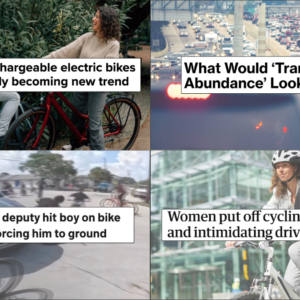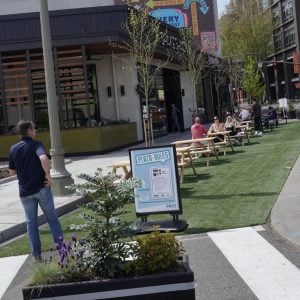Tomorrow, the Community Policing Agreement that was first proposed by Police Chief Rosie Sizer following two high-profile fatalities in October of 2007, will be adopted by Portland City Council.
The five page document outlines the current state of the working relationship between the Bureau of Transportation, the Police Bureau, the Bicycle Transportation Alliance, and the Willamette Pedestrian Coalition.
Here’s an excerpt from the introduction to the agreement (which you can download as a PDF here) :
…Portland’s community vision has resulted in a transformation of the public right-of-way that promotes all forms of travel….
This agreement will formalize a collaborative approach that will improve the city’s planning and response to traffic related issues, and encourage all modes of travel to work together harmoniously…
This collaborative approach depends on input and participation by the community….
…By working together, we can improve problem solving efforts and information exchange and develop innovative, pleasant, and safe places for all modes of travel.”
Following the introduction, the agreement lays out several “action strategies”. These include:
- An increased level of communication and cooperation among the community and key stakeholders with transportation responsibilities.
- A collaborative approach to traffic safety strategies, including the development and implementation of legislative initiatives.
- An agreement about the top locations with the greatest need for improved safety. This list will be reviewed annually.
- Improved data collection processes to accurately inform the community of safety trends, both city-wide and at specific locations.
The document than lists responsibilities that each signing member of the agreement will be held to.
Highlights on the list of 19 responsibilities the Police Bureau is agreeing are a commitment to “proactively work” with PBOT, the BTA and the WPC to identify high-risk locations that could benefit from “focused enforcement”, to formalize the “police bicycle officer liaison position” currently held by Officer Robert Pickett, and to improve “problem solving efforts with the transportation community” by having Traffic Division leaders present at bike and pedestrian related meetings.
Highlight of PBOT’s list of responsibilities are to meet monthly with Traffic Division officers to “exchange information and discuss problem solving efforts” and to create a list of high-risk locations that is updated and reviewed annually to improve safety efforts.
For advocates at the BTA and WPC, they’re agreeing to continue to actively share information with PBOT and the Police Bureau and to maintain the collaborative relationship that currently exists.
Bryan Parman, interim commander of the Traffic Division (while Eric Hendricks recovers from an automobile crash) acknowledges that nearly everything in the agreement is already taking place. “We’re already doing most everything in the agreement,” he told me last night, “but what this does is put it in writing. It also must be renewed each year, so we can look back and assess how we’re doing.”
If you’d like to show your support for the importance of a collaborative and productive relationship between the Police Bureau and the community, consider showing up and/or testifying at City Council tomorrow at 2:00pm.







Thanks for reading.
BikePortland has served this community with independent community journalism since 2005. We rely on subscriptions from readers like you to survive. Your financial support is vital in keeping this valuable resource alive and well.
Please subscribe today to strengthen and expand our work.
Formalizing and setting a schedule for review of these relationships seems like a step in the right direction. I am looking forward to a more concerted effort in targeted enforcement to shape road users behavior rather than just seemingly blanket enforcement (which smacks of a revenue push) to the letter of the law. Targeting those whose egregious flaunting of the spirit of the law which in turn erodes good will between different modes of road users will defuse tensions and foster responsibility.
As outlined in the recent video for officers’ enforcement guidelines regarding inter modal traffic conflict, I applaud the emphasis on informing and relying more upon the discretion of the officer on scene to give more weight to the intent of the road user rather than strictly the letter of the law. Rewarding responsible intent with fair enforcement will go a lot further than blind, blanket enforcement to the letter of the law. Yeah, I’m referring mostly, but not exclusively, to complete stop vs. slow way way down vs. unsafe blowing of the stop.
I’m hoping to see:
1. More enforcement against people whose absolute disregard for the law puts those who are trying to actually share the road at risk. As an example, there are several intersections I frequent that are notorious for having their traffic controls utterly disregarded by a consistent segment of all types of road users. It is so consistent that I feel endangered when I obey the rules (getting hit from behind for stopping at a stop sign?). I hope the traffic controls can be made more appropriate to the reasonable use of the intersection so that all users feel that it is in their best interest to behave predictably within the intent of the law.
2. Bike theft stings. Do they happen? I know I’m not alone in having WAY MORE $$ invested in my bikes than my motorized vehicles (also reflected in their proportion of use). I believe there is an auto theft task force within the PPB, where’s the pro-active bike theft enforcement?
Anyway, a step in the right direction.
I think that one of the missing ingredients in this formula is finding a way to get the police to experience multiple modes of transportation, while dressed like civilians, i.e. during their commute to work.
I’m convinced that the more we can get them to use multiple modes of transportation (sans the “POLICE” jersey) the more they might start to understand the perspectives of walkers, bikers and public transportation riders.
I’d be curious to know what the percentage breakdown is for the various modes of getting to work for the police. My guess is that it is not representative of the city at large.